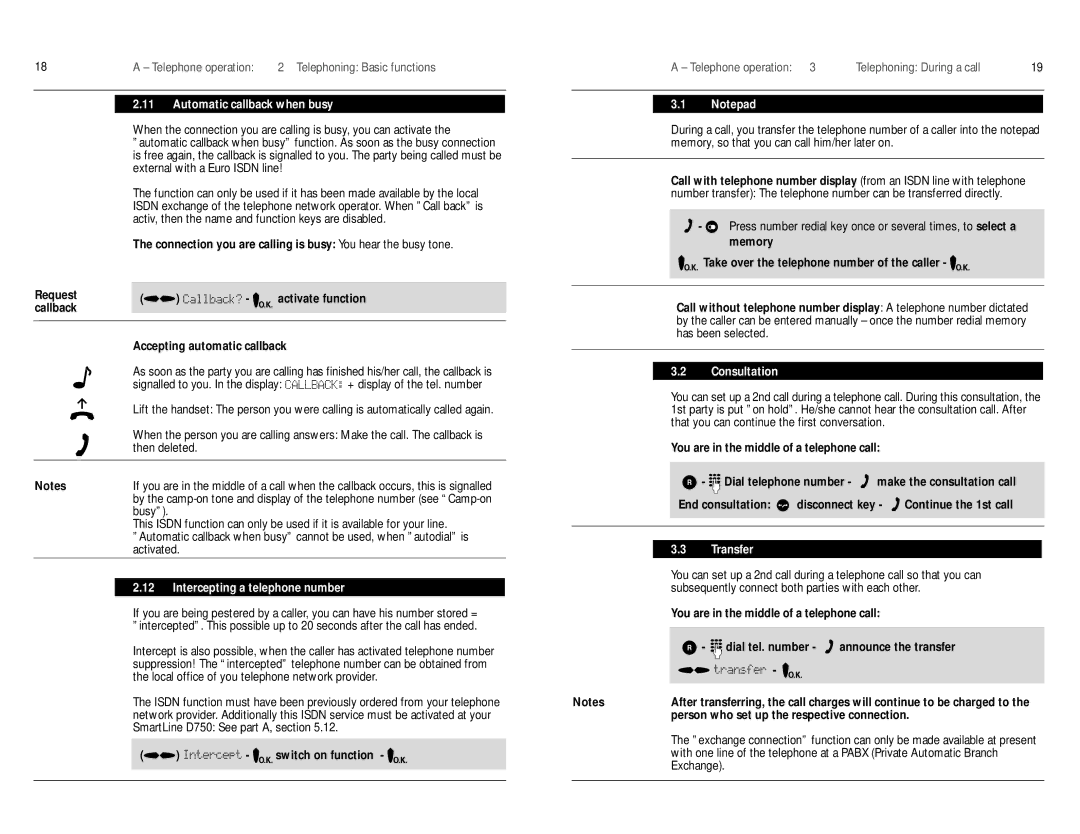
18 | A – Telephone operation: | 2 Telephoning: Basic functions |
2.11Automatic callback when busy
When the connection you are calling is busy, you can activate the
”automatic callback when busy” function. As soon as the busy connection is free again, the callback is signalled to you. The party being called must be external with a Euro ISDN line!
The function can only be used if it has been made available by the local ISDN exchange of the telephone network operator. When ”Call back” is activ, then the name and function keys are disabled.
| The connection you are calling is busy: You hear the busy tone. | ||||
Request |
|
|
|
| |
( | ) | - | activate function | ||
callback |
|
|
|
|
|
|
|
|
|
|
|
| Accepting automatic callback |
| |||
| As soon as the party you are calling has finished his/her call, the callback is | ||||
| signalled to you. In the display: | + display of the tel. number | |||
Lift the handset: The person you were calling is automatically called again.
When the person you are calling answers: Make the call. The callback is then deleted.
Notes |
| If you are in the middle of a call when the callback occurs, this is signalled | |||
|
| by the | |||
|
| busy”). |
|
|
|
|
| This ISDN function can only be used if it is available for your line. | |||
|
| ”Automatic callback when busy” cannot be used, when ”autodial” is | |||
|
| activated. |
|
| |
|
|
| |||
|
| 2.12 Intercepting a telephone number | |||
|
| If you are being pestered by a caller, you can have his number stored = | |||
|
| ”intercepted”. This possible up to 20 seconds after the call has ended. | |||
|
| Intercept is also possible, when the caller has activated telephone number | |||
|
| suppression! The “intercepted” telephone number can be obtained from | |||
|
| the local office of you telephone network provider. | |||
|
| The ISDN function must have been previously ordered from your telephone | |||
|
| network provider. Additionally this ISDN service must be activated at your | |||
|
| SmartLine D750: See part A, section 5.12. | |||
|
|
|
|
| |
|
| ( | ) | - | switch on function - |
|
|
|
|
|
|
|
|
|
|
|
|
A – Telephone operation: | 3 | Telephoning: During a call | 19 |
3.1Notepad
During a call, you transfer the telephone number of a caller into the notepad memory, so that you can call him/her later on.
Call with telephone number display (from an ISDN line with telephone number transfer): The telephone number can be transferred directly.
- ![]() Press number redial key once or several times, to select a
Press number redial key once or several times, to select a
memory
Take over the telephone number of the caller - ![]()
Call without telephone number display: A telephone number dictated by the caller can be entered manually – once the number redial memory has been selected.
3.2Consultation
You can set up a 2nd call during a telephone call. During this consultation, the 1st party is put ”on hold”. He/she cannot hear the consultation call. After that you can continue the first conversation.
You are in the middle of a telephone call:
![]() -
- ![]()
![]()
![]() Dial telephone number -
Dial telephone number - ![]() make the consultation call
make the consultation call
End consultation: ![]() disconnect key -
disconnect key - ![]() Continue the 1st call
Continue the 1st call
3.3Transfer
You can set up a 2nd call during a telephone call so that you can subsequently connect both parties with each other.
You are in the middle of a telephone call:
| - | dial tel. number - | announce the transfer |
|
| - |
|
Notes | After transferring, the call charges will continue to be charged to the | ||
| person who set up the respective connection. | ||
The ”exchange connection” function can only be made available at present with one line of the telephone at a PABX (Private Automatic Branch Exchange).
